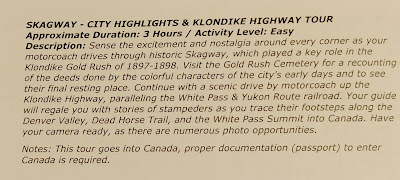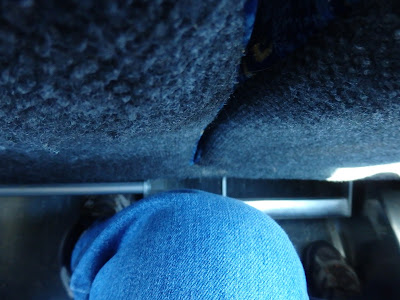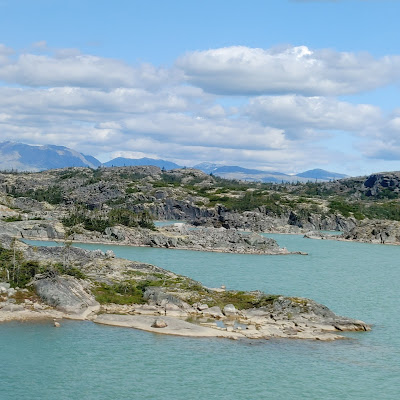 |
| One of the few complains we had of our cabin was the placement of the faucet. We had to keep a towel by it because we watered the counter every time we washed our hands. |
 |
| Tenders waiting to pick up people. |
 |
| What was really weird is that we were at the dock. |
 |
| Note how businesses had used the rocks to put up advertisements. |
 |
| I found this sign on shore that showed us where our ship was docked. |
 |
| Front of the Nieuw Amsterdam from the shore. |
 |
| The larger ships, Quantum of the Seas (4,180 passengers) and the Disney Wonder (2,400), behind the small boat harbor |
 |
| There were a lot of helicopter tours from Skagway. |
 |
| Sign on a cafe along the bayfront. |
 |
| Description of our tour for the day. |
 |
| One of Nolan's biggest complaints for the whole trip was the legroom on the buses. Here he just had enough. |
 |
| As the bus started into Skagway, we passed these restrooms where they were labeled with native names. |
 |
| We had seen one of these rotary train plows in Duluth, MN in 1992. |
 |
| This building, whose facade is made of 1,000's of pieces of driftwood, was the meeting house of the Arctic Brotherhood. It is now an information center. From the Arctic Brotherhood website (Arctic Brotherhood – "Ordinary Men on Extraordinary Adventures Since 1899" ) "The Arctic Brotherhood was formed as a fraternal organization in 1899 by gold-seeking stampeders headed for the Klondike. It wasn’t long before every northern frontier town, settlement and mining camp of any importance boasted its Arctic Brotherhood chapter. Eventually 32 original Camps were established; and at its height, the Arctic Brotherhood boasted some 10,000 members." |
 |
| Heading out of town, we crossed the Skagway River. |
 |
| Notice the tree covered mountains. Where we are going, there are way less trees due to the harsh environment they have to grow in. |
 |
| Pitchfork Falls runs out of Goat Lake, high up in the mountains. |
 |
| Markers for the snow plows |
 |
| We stopped at pullout so we could look back at the Captain William Henry Moore Bridge and the bypass that we used to cross the creek. |
 |
| From the pullout we could look down the William Henry Moore Creek, which eventually runs into the Skagway River. |
 |
| Our bus was from the Yukon. |
 |
| The US/Canadian border. |
 |
| We stopped at the Skagway Grade Summit Rest area, called the international restrooms by our driver/tour guide. |
 |
| She talked about how hard this area was to traverse on foot due to all the rocks. This, and the many ponds and lakes, made the Yukon gold seekers to go through here in the winter. |
 |
| Back on the road, we saw many ponds and lakes. |
 |
| I was struck by the varying colors of the ponds. Maybe one was mostly glacier run off and the other just melted snow? |
 |
| These trees grow this way due to the harsh weather conditions and wind. |
 |
| We went through the Canadian checkpoint then stopped at the Fraser Lookout. |
 |
| Interesting. Welcome to the Yukon even though we were still in British Columbia. |
 |
| Notice the railroad tracks run just below the overlook. |
 |
| Heading back down the highway, we could see the north end of the now abandoned Captain William Henry Moore Bridge. |


































































No comments:
Post a Comment